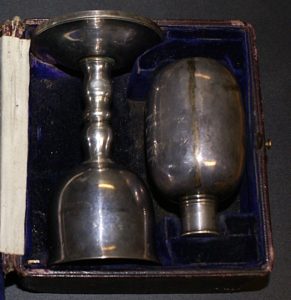Communion

Du Vernet excitedly recounts the communion service during his first Sunday “in a mission to the heathen.” It’s not hard to understand Du Vernet’s enthusiasm, considering that for him, Holy Communion was a ritual of profound connection between Jesus and the Christians gathered in a Church to worship him.
The Holy Communion, or the Eucharist as it is often called, varies greatly across Christianity in both doctrine and practice. Du Vernet describes the Anglican version of the ceremony, though even within Anglicanism there are differences. Nonetheless, most practices involve a priest ritually distributing wine and bread to be consumed by the congregation. Christians generally recognize a special presence of Christ in the bread and the wine, though the theology behind this presence varies, sometimes controversially. For example, some missionaries worried about the similarities between the Communion ritual and other rituals of symbolic eating of human flesh found among their would-be converts—and about how to explain that the Eucharist was not a kind of cannibalism.
In the communion Du Vernet describes, Jeremiah Johnston distributed the wine while Du Vernet provided the bread. Ten people were in attendance, half of whom were Ojibwe. In his diary, Du Vernet called the service a treaty covenant. He later expanded on what he meant in a Christian newsletter: “knowing that all the Indians were familiar with the thought of a treaty, I endeavored to fix in their minds the idea of a Covenant Feast.” By suggesting that the bread and wine of Communion were parallel to the treaties signed between the Queen and the Ojibwe, Du Vernet implied that loyalty to Christ was also loyalty to the Queen. What this meant in terms of the Ojibwe side of the treaty relationship, anchored in their own understandings of the Creator, is hard to say. All in all, Du Vernet approvingly called his celebration of communion a solemn feast.